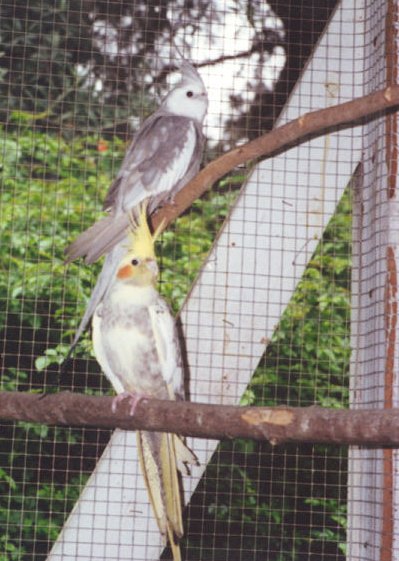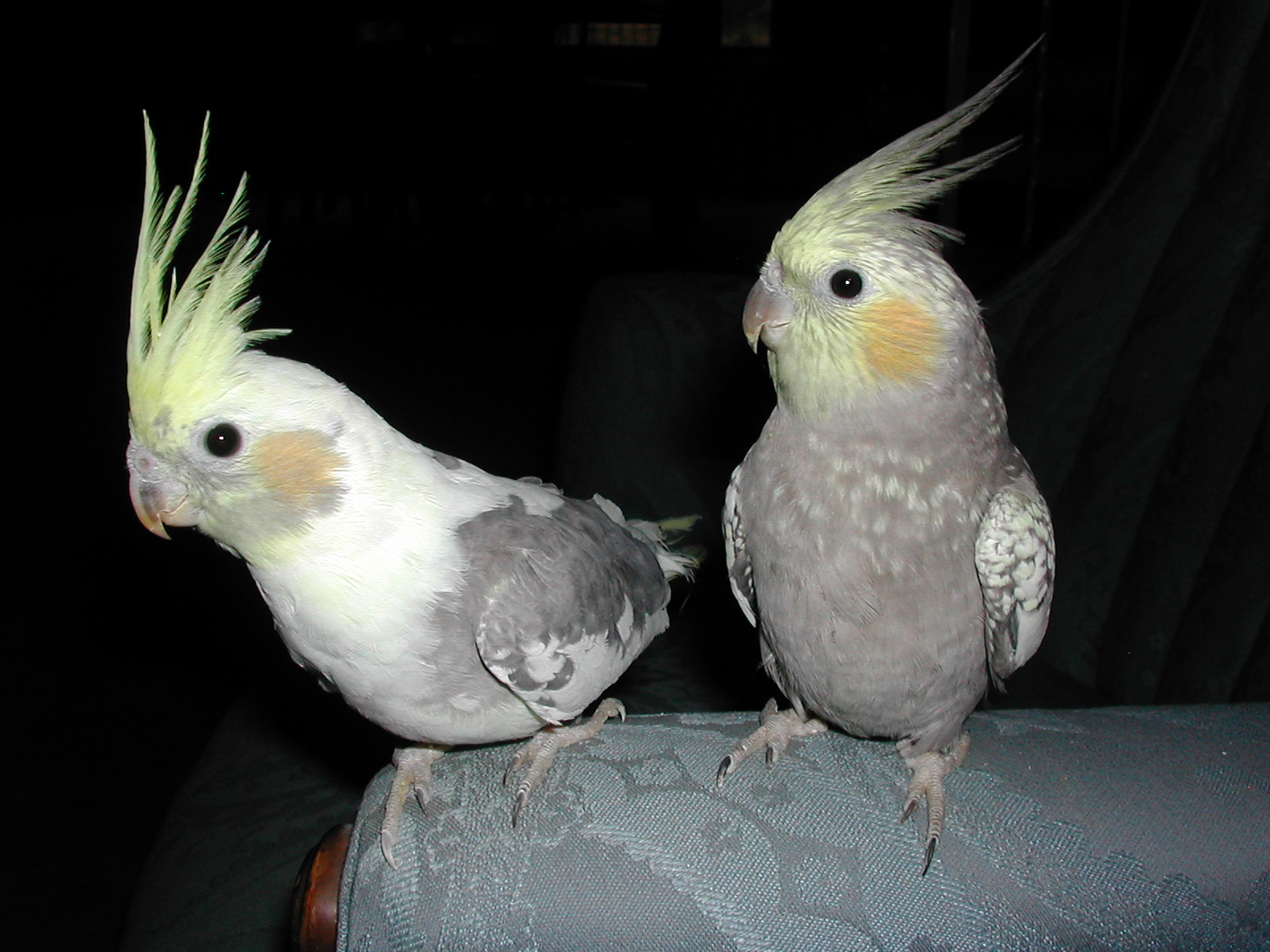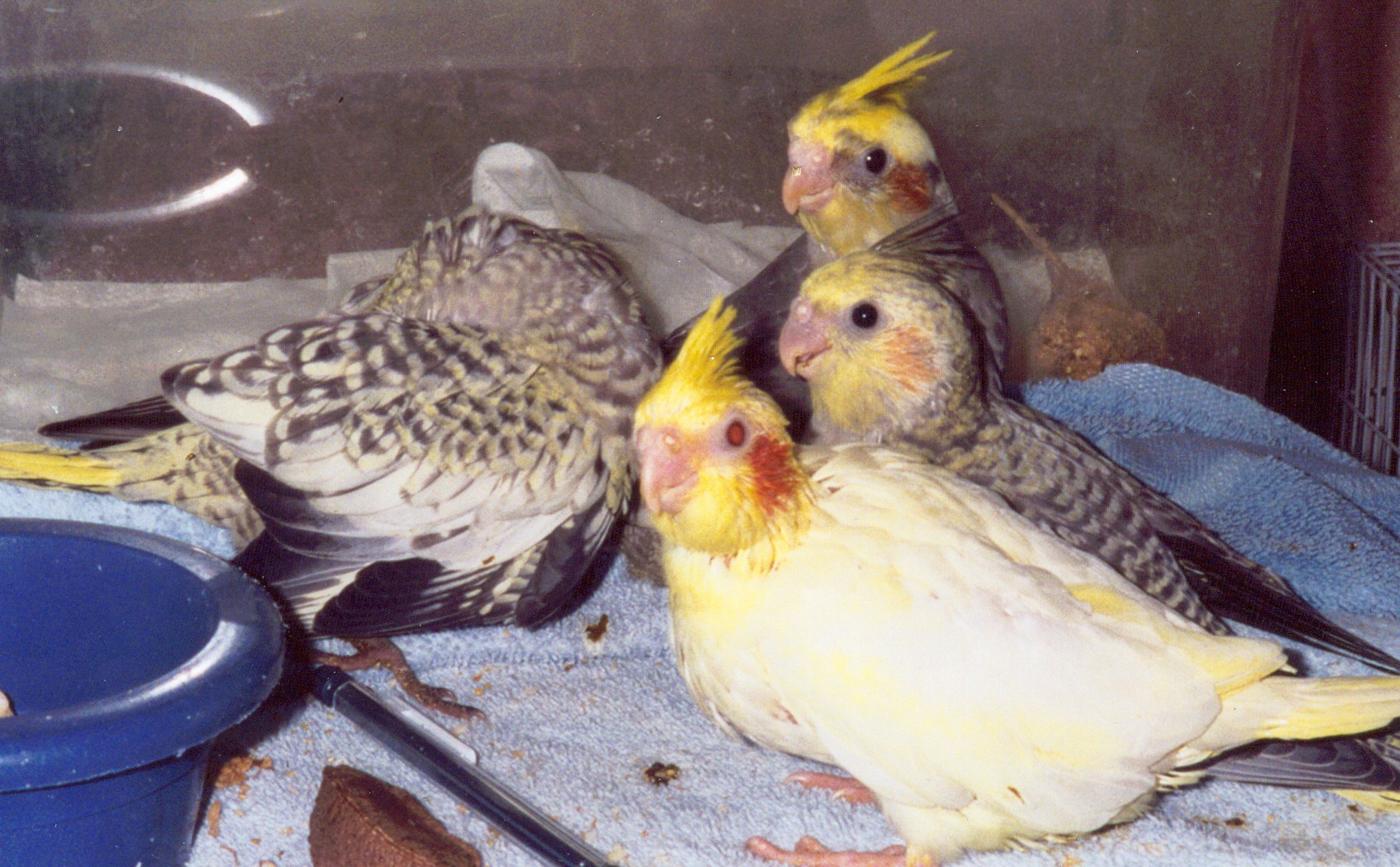

The Setup
As with any colony breeding situation, provide more nestboxes than pairs. It is best to provide a battery of boxes when they are first introduced, then remove some of the excess once everyone has staked out their own. Always leave a few extra boxes around for the pairs who like to swap boxes after each clutch. Cockatiels can be given lovebird or cockatiel size nestboxes. My cockatiels, if given the choice, will always pick the smaller lovebird box over the roomy cockatiel one. Lovebird boxes are only slightly larger than budgie boxes, with an enlarged entrance. The chicks will take up most of the room in the box, and rapidly fill it up with feces that then begin to grow fungus. Because of this, it is imperative that you clean out the box as often as possible once the chicks arrive.
Sexing & Breeding Behavior
Tiels can be sexed visually or by behavior. I already have a full article on how to sex cockatiels visually. Males are very easy to identify by their behavior. At around six months old they begin to whistle and show off. Though a few wayward hens can learn a tune, this is an exception, and you can accurately sex cockatiels by their whistling ability. Courtship behavior is easy to recognize. The male usually holds his wings out from his body slightly, stands on his toes (so to speak) and whistles while moving his head about. If a hen is willing to copulate, she will lower hear head and raise her tail. The male may continue to whistle during copulation, and the hen usually makes little cooing noises.
Tiels form strong pair bonds and are much pickier about their mates than are budgies, which donít really seem to care. A bonded pair of tiels is easy to spot, since they always sit together and follow each other around the aviary. They will also call and show distress if separated.
I have not made sufficient observations to be able to determine if cockatiels are fairly monogamous or not. Usually I determine fickle partners by mutations showing up in the chicks that shouldnít be there. However, most of my cockatiels carry the same mutations so I have no way, aside from careful observation, to determine if pairs are not truly monogamous. I do have one proven case of outbreeding- a lutino chick appeared in the nest of a normal hen and a normal split-to-pied male. This particular male had only one foot, and after three infertile clutches the hen decided to outbreed. My guess is that this species is fairly monogamous, and that colony breeding should not pose a significant problem to breeders interested in controlling the genetic make-up of their birds, so long as they use bonded pairs.
Raising the Chicks
Cockatiels usually lay 4-8 eggs, which hatch 21 days after incubation begins. I already have an article on cockatiel growth and an accompanying visual guide. Unlike budgies, which are born naked, tiels hatch with a fluffy layer of yellow down (white down for whiteface mutations). Once fairly alert, chicks will hiss loudly and rock from side to side if alarmed. This has startled more than one of my coworkers, who didnít know what was in the plastic brooder left in the breakroom.
I get a lot of letters from people who have bought handfed 7-8 week-old cockatiels. This is disturbing. Cockatiels should not be weaning this young, and from the sound of the letters, these birds were force-weaned. Force-weaning is the practice of depriving the chicks of food, requiring them to eat on their own earlier than they should. Birds that are weaned in this manner often revert back to begging, bobbing while making a grating noise, a display which new pet owners do not know the implications of. These birds may also develop phobias of food and general insecurities about their environment. If you have one of these birds, it will need to offer it "security food." Try soaking pellets in warm water and offering them by hand. You can also heat baby cereal, oatmeal or applesauce and offer it by spoon. If begging behavior persists, you may need to consult a veterinarian or a professional bird behaviorist.
 Cockatiels can be set up singly or in colonies. I prefer to set all my birds up in communal flights, so I colony breed my cockatiels in a mixed aviary with my budgies. In 2000 I tried setting up a few pairs in my kakariki aviary. Two pairs did fine, but the third kept abandoning or killing its chicks before they were two weeks old. After moving them out of the kak aviary and setting them up with budgies and tiels, this pair performed fine. The kaks may have been raiding the nest or just causing trouble.
Cockatiels can be set up singly or in colonies. I prefer to set all my birds up in communal flights, so I colony breed my cockatiels in a mixed aviary with my budgies. In 2000 I tried setting up a few pairs in my kakariki aviary. Two pairs did fine, but the third kept abandoning or killing its chicks before they were two weeks old. After moving them out of the kak aviary and setting them up with budgies and tiels, this pair performed fine. The kaks may have been raiding the nest or just causing trouble. There are three families in the order Psittaformes: Cacatuidae (cockatoos), Loriidae (lories) and Psittacidae (everything else). In most parrots species, the female lays and incubates the eggs. The maleís sole job is to provide food to her so that she does not have to leave the nest. Once the chicks hatch, he feeds her and she feeds the chicks. Once the chicks fledge, both parents forage and feed the chicks. Cockatiels are actually members of the family Cacatuidae, and display reproductive behaviors unique to that family. Both parents share incubation and feeding duties. Some of the sources Iíve read said that females incubate at night and males incubate during the day. I have not found this to be true. My cockatiels take turns throughout the day, and sometimes both birds can be found in the box together. When I provide the soft food, whichever bird is out will fill up and then enter the nestbox, at which point the partner will exit and proceed to eat their own share of the food.
There are three families in the order Psittaformes: Cacatuidae (cockatoos), Loriidae (lories) and Psittacidae (everything else). In most parrots species, the female lays and incubates the eggs. The maleís sole job is to provide food to her so that she does not have to leave the nest. Once the chicks hatch, he feeds her and she feeds the chicks. Once the chicks fledge, both parents forage and feed the chicks. Cockatiels are actually members of the family Cacatuidae, and display reproductive behaviors unique to that family. Both parents share incubation and feeding duties. Some of the sources Iíve read said that females incubate at night and males incubate during the day. I have not found this to be true. My cockatiels take turns throughout the day, and sometimes both birds can be found in the box together. When I provide the soft food, whichever bird is out will fill up and then enter the nestbox, at which point the partner will exit and proceed to eat their own share of the food. If you want to learn how to handfeed, this is the ideal species to start with. Cockatiels have a strong feeding response in the form of a pumping motion. Most sources recommend pulling chicks at three weeks for handfeeding, but I feel this is a bit too old. All my species are pulled once they have pinfeathers, but before the pinfeathers open. For cockatiels, this means two weeks old. At this age you can feed them every 4-6 hours, starting early in the morning and ending late at night. My parent-raised cockatiels usually wean no earlier than 11 weeks. Many will successfully solicit food from their parents for even longer periods. My handfeds typically take longer, and wean at 12-15 weeks. Weaning should always be done according to the individual birdís pace.
If you want to learn how to handfeed, this is the ideal species to start with. Cockatiels have a strong feeding response in the form of a pumping motion. Most sources recommend pulling chicks at three weeks for handfeeding, but I feel this is a bit too old. All my species are pulled once they have pinfeathers, but before the pinfeathers open. For cockatiels, this means two weeks old. At this age you can feed them every 4-6 hours, starting early in the morning and ending late at night. My parent-raised cockatiels usually wean no earlier than 11 weeks. Many will successfully solicit food from their parents for even longer periods. My handfeds typically take longer, and wean at 12-15 weeks. Weaning should always be done according to the individual birdís pace.

Thanks to Pam Bowman for the great pic of a tiel couple! This article and its images are © 2003 by Karen Trinkaus unless otherwise noted and may not be reprinted or used in any way without the author's permission.